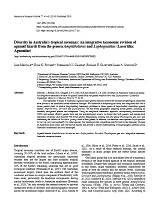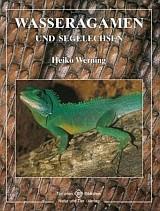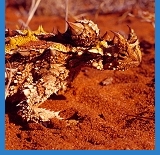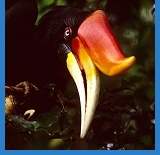




Related bibliographies:
Reptiles
 Lizards Lizards
 Agamidae Agamidae
Australia
Malay Archipelago






































































































































































































































































































































| |

Bibliography of the genus
Amphibolurus (Southern Lashtail Dragons)

(Reptilia: Sauria: Agamidae)
Note:
In order to limit redundancy, relevant literature indexed in the related bibliographies in the left column may not have been included in this page. For a comprehensive search of literature, these bibliographies should therefore also be consulted.
Amphibolurus in general
 |
Bradshaw, S.D. 1981. Ecophysiology of Austrialian desert lizards: studies on the genus Amphibolurus. Monographiae Biologicae 41(2): 1393-1434.
Bradshaw, S.D.; Main, A.R. 1968. Behavioural attitudes and regulation of temperature in Amphibolurus lizards. Journal of Zoology (London) 154: 193-221.
Coleman, E. 1944. Lizards under domestication. Victorian Naturalist (Melbourne) 61(8): 137-138.
Davidge, C. 1980. Reproduction in the herpetofaunal community of a Banksia woodland near Perth, W.A. Australian Journal of Zoology 28(3): 435-443.
James, C.; Shine, R. 1985. The seasonal timing of reproduction: a tropical-temperate comparison in Australian lizards. Oecologia (Heidelberg) 67(4): 464-474.
Melville, J.; Ritchie, E.G.; Chapple, S.N.J.; Glor, R.E.; Schulte, J.A. 2011. Evolutionary origins and diversification of dragon lizards in Australia's tropical savannas. Molecular Phylogenetics and Evolution 58(2): 257-270.
Melville, J.; Ritchie, E.G.; Chapple, S.N.J.; Glor, R.E.; Schulte, J.A. 2018. Diversity in Australia’s tropical savannas: An integrative taxonomic revision of agamid lizards from the genera Amphibolurus and Lophognathus (Lacertilia: Agamidae). Memoirs of Museum Victoria 77: 41–61.
Peters, W.C.H. 1866. Über neue Amphibien (Amphibolurus, Lygosoma, Cyclodus, Masticophis, Crotaphopeltis) und Fische (Diagramma, Hapalogenys) des Kgl. zoologischen Museums. Monatsberichte der Königlich Akademie der Wissenschaften zu Berlin 1866(February): 86-96.
Storr, G.M. 1974. Agamid lizards of the genera Caimanops, Physignathus and Diporiphora in Western Australia and Northern Territory. Records of the Western Australian Museum 3(2): 121-146.
Storr, G.M. 1982. Revision of the bearded dragons (Lacertilia: Agamidae) of Western Australia with notes on the dismemberment of the genus Amphibolurus. Records of the Western Australian Museum 10(2): 199-214.
Warburg, M.R. 1965. Studies on the environmental physiology of some Australian lizards from arid and semi-arid habitats. Australian Journal of Zoology 13: 563-575.
Werning, H. 1995. Wasseragamen. Heselhaus und Schmidt Verlag, Munster. 96 pp.
Werning, H. 2002. Wasseragamen und Segelechsen. Natur und Tier-Verlag, Münster. 127 pp.
Werning, H. 2004. Bibliographie der Gattungen Physignathus, Lophognathus und Hydrosaurus. Iguana Rundschreiben 17(2): 18-31.
|
Amphibolurus burnsi
 |
Ellis, M.; Higgins, D. 1993. The occurrence of Gilbert's dragon Lophognathus gilberti in the Paroo Drainage Basin, western New South Wales. pp. 35-36. In: Lunney, D. & Ayers, D. (eds.). Herpetology in Australia: a diverse discipline. Surrey Beatty & Sons, Chipping Norton, New South Wales. 414 pp.
Melville, J.; Ritchie, E.G.; Chapple, S.N.J.; Glor, R.E.; Schulte, J.A. 2011. Evolutionary origins and diversification of dragon lizards in Australia's tropical savannas. Molecular Phylogenetics and Evolution 58(2): 257-270.
|
Amphibolurus centralis
 |
Loveridge, A. 1933. New agamid lizards of the genera Amphibolurus and Physignathus from Australia. Proceedings of the New England Zoological Club 13: 69-72.
Melville, J.; Ritchie, E.G.; Chapple, S.N.J.; Glor, R.E.; Schulte, J.A. 2011. Evolutionary origins and diversification of dragon lizards in Australia's tropical savannas. Molecular Phylogenetics and Evolution 58(2): 257-270.
Stettler, P.H. 1960. Aus dem Gefangenleben von Gilbert's Wasseragame Physignatus gilberti centralis Loveridge. DATZ (Die Aquarien- und Terrarien-Zeitschrift) 13: 54-56.
|
Amphibolurus muricatus
 |
Allen, E.; Sinclair, D.; Allen, S.; Peters, R. 2009. Natural history notes: Amphibolurus muricatus (Jacky Dragon). Avian predation. Herpetological Review 40(1): 82-83.
Banks, C.B. 1987. Notes on birth and early development in three species of common Victorian reptiles. Victorian Naturalist 104(6): 178-182.
Barquero, M.D.; Peters, R.; Whiting, M.J. 2015. Geographic variation in aggressive signalling behaviour of the Jacky Dragon. Behavioral Ecology and Sociobiology 69(9): 1501-1510.
Carlile, P.A.; Peters, R.A.; Evans, C.S. 2006. Detection of a looming stimulus by the Jacky Dragon: selective sensitivity to characteristics of an aerial predator. Animal Behaviour 72(3): 553-562.
Carpenter, C.C.; Badham, J.A.; Kimble, B. 1970. Behaviour patterns of three species of Amphibolurus (Agamidae). Copeia 1970: 497-505.
Chong, G.; Heatwole, H.; Firth, B.T. 1973. Panting thresholds of lizards - 2. Diel variation in the panting threshold of Amphibolurus muricatus. Comparative Biochemistry and Physiology (A) 46(4): 827-829.
Dyk, D.A. van; Evans, C.S. 2007. Familiar-unfamiliar discrimination based on visual cues in the Jacky Dragon, Amphibolurus muricatus. Animal Behaviour 74(1): 33-44.
Dyk, D.A. van; Evans, C.S. 2008. Opponent assessment in lizards: examining the effect of aggressive and submissive signals. Behavioral Ecology 19(4): 895-901.
Dyk, D.A. van; Taylor, A.J.; Evans, C.S. 2007. Assessment of repeated displays: a test of possible mechanisms. Journal of Experimental Biology 210(17): 3027-3035.
Esquerré, D.; Keogh, J.S.; Schwanz, L.E. 2014. Direct effects of incubation temperature on morphology, thermoregulatory behaviour and locomotor performance in jacky dragons (Amphibolurus muricatus). Journal of Thermal Biology 43: 33-39.
Firth, B.T.; Heatwole, H. 1976. Panting thresholds of lizards: the role of the pineal complex in panting responses in an argamid, Amphibolurus muricatus. General Comp. Endocr. 29(3): 388-401.
Hall, J.M.; Warner, D.A. 2017. Winter microhabitat selection and growth of Jacky Dragons (Amphibolurus muricatus). Copeia 105(4): 618–625.
Harlow, P.S.; Taylor, J.E. 2000. Reproductive ecology of the Jacky Dragon (Amphibolurus muricatus): An agamid lizard with temperature-dependent sex determination. Austral Ecology 25(6): 640-652.
Hawker, M. 1996. Captive maintenance and breeding of the Tree Dragon Amphibolurus muricatus. Monitor (Journal of the Victorian Herpetological Society) 8(2): 78-83
Heatwole, H.; Firth, B.T. 1982. Voluntary maximum temperature of the jackie lizard Amphibolurus muricatus. Copeia 1982(4): 824-829.
Heatwole, H.; Firth, B.T.; Stoddart, H. 1975. Influence of season, photoperiod and thermal acclimation on the panting threshold of Amphibolurus muricatus. Journal of Experimental Zoology 191(2): 183-192.
Heatwole, H.; Zvetovka, L.I.; Firth, B.T.; Webb, G.J.W. 1973. Panting thresholds of lizards - l. Some methodological and internal influences on the panting threshold of an agamid, Amphibolurus muricatus. Comparative Biochemistry and Physiology (A) 46(4): 799-826.
Hitchen, D.; Burgin, S.; Wotherspoon, D. 2011. Notes on the size structure of a population of the Jacky Dragon Amphibolurus muricatus in a small fragmented urban remnant. Pacific Conservation Biology 16(4): 237-243.
Hitchen, D.J.; Burgin, S.; Ridgeway, P.; Wotherspoon, D. 2011. Habitat use by the jacky lizard Amphibolurus muricatus in a highly degraded urban area. Animal Biology (Leiden) 61(2): 185-197.
Hoese, F.; Peters, R.A.; Evans, C.S. 2008. The effect of variation in prey movement on the predatory response of jacky lizards (Amphibolurus muricatus). Ethology 114(7): 718-727.
Homan, P. 2006. New locality records for reptiles, including the vulnerable swamp skink Egernia coventryi, in South Gippsland, 2001 - 2005. Victorian Naturalist (Blackburn) 123(5): 335-338.
Kubiak, P.J. 2011. Predation by a Jacky Lizard Amphibolurus muricatus (Agamidae) upon nesting Banded Bees Amegilla sp (Apidae). Victorian Naturalist (Blackburn) 128(2): 86-89.
Letnic, M.I.; Fox, B.J. 1997. The impact of industrial fluoride fallout on faunal succession following sand mining of dry sclerophyll forest at Tomago, NSW. - 1. Lizard recolonisation. Biological Conservation 80(1): 63-81.
Lord, C.E.; Scott, H.H. 1924. A Synopsis of the Vertebrate Animals of Tasmania. Oldham, Beddome and Meredith, Hobart. 340 pp.
Nelson, X.J.; Garnett, D.T.; Evans, C.S. 2010. Receiver psychology and the design of the deceptive caudal luring signal of the death adder. Animal Behaviour 79(3): 555-561.
Ord, T.J.; Evans, C.S. 2002. Interactive video playback and opponent assessment in lizards. Behavioural Processes 59(2): 55-65.
Ord, T.J.; Evans, C.S. 2003. Display rate and opponent assessment in the Jacky Dragon (Amphibolurus muricatus): An experimental analysis. Behaviour 140(11-12): 1495-1508.
Ord, T.J.; Peters, R.A.; Evans, C.; Taylor, A.J. 2002. Digital video playback and visual communication in lizards. Animal Behaviour 63(5): 879-890.
Parmenter, C.J.; Heatwole, H. 1975. Panting thresholds of lizards. 4. The effect of dehydration on the panting threshold of Amphibolurus barbatus and Amphibolurus muricatus. Journal of Experimental Zoology 191(3): 327-332.
Pepper, M.; Barquero, M.D.; Whiting, M.J.; Keogh, J.S. 2014. A multi-locus molecular phylogeny for Australia's iconic Jacky Dragon (Agamidae: Amphibolurus muricatus): phylogeographic structure along the Great Dividing Range of south-eastern Australia. Molecular Phylogenetics and Evolution 71: 149-156.
Peters, R.A. 2008. Environmental motion delays the detection of movement-based signals. Biology Letters 4(1): 2-5.
Peters, R.A.; Allen, S.J. 2009. Movement signal choreography unaffected by receiver distance in the Australian Jacky lizard, Amphibolurus muricatus. Behavioral Ecology and Sociobiology 63(11): 1593-1602.
Peters, R.A.; Clifford, C.W.G.; Evans, C.S. 2002. Measuring the structure of dynamic visual signals. Animal Behaviour 64(1): 131-146.
Peters, R.A.; Evans, C.S. 2003. Design of the Jacky Dragon visual display: Signal and noise characteristics in a complex moving environment. Journal of Comparative Physiology A Sensory Neural and Behavioral Physiology 189(6): 447-459.
Peters, R.A.; Evans, C.S. 2003. Introductory tail-flick of the Jacky Dragon visual display: Signal efficacy depends upon duration. Journal of Experimental Biology 206(23): 4293-4307.
Peters, R.A.; Evans, C.S. 2007. Active space of a movement-based signal: response to the Jacky Dragon (Amphibolurus muricatus) display is sensitive to distance, but independent of orientation. Journal of Experimental Biology 210(3): 395-402.
Peters, R.A.; Ord, T.J. 2003. Display response of the Jacky Dragon, Amphibolurus muricatus (Lacertilia: Agamidae), to intruders: a semi-Markovian process. Austral Ecology 28(5): 499-506.
Radder, R.S.; Warner, D.A.; Shine, R. 2007. Compensating for a bad start: catch-up growth in juvenile lizards (Amphibolurus muricatus, Agamidae). Journal of Experimental Zoology Part A-Ecological Genetics and Physiology 307A(9): 500-508.
Ramos, J.A.; Peters, R.A. 2017. Habitat-dependent variation in motion signal structure between allopatric populations of lizards. Animal Behaviour 126: 69-78
Rojas, A.D.; Koertner, G.; Geiser, F. 2012. Cool running: locomotor performance at low body temperature in mammals. Biology Letters 8(5): 868-870.
Shine, R.; Warner, D.A.; Radder, R.S. 2007. Windows of embryonic sexual lability in two lizard species with environmental sex determination. Ecology (Washington, D.C.) 88(7): 1781-1788.
Warner, D.A. 2007. Natural history notes: Amphibolurus muricatus (Jacky Dragon). Predation. Herpetological Review 38(4): 449.
Warner, D.A.; Lovern, M.B.; Shine, R. 2007. Maternal nutrition affects reproductive output and sex allocation in a lizard with environmental sex determination. Proceedings of the Royal Society Biological Sciences Series B 274(1611): 883-890.
Warner, D.A.; Lovern, M.B.; Shine, R. 2008. Maternal influences on offspring phenotypes and sex ratios in a multi-clutching lizard with environmental sex determination. Biological Journal of the Linnean Society 95(2): 256-266.
Warner, D.A.; Shine, R. 2005. The adaptive significance of temperature-dependent sex determination: Experimental tests with a short-lived lizard. Evolution 59(10): 2209-2221.
Warner, D.A.; Shine, R. 2006. Morphological variation does not influence locomotor performance within a cohort of hatchling lizards (Amphibolurus muricatus, Agamidae). Oikos 114(1): 126-134.
Warner, D.A.; Shine, R. 2007. Fitness of juvenile lizards depends on seasonal timing of hatching, not offspring body size. Oecologia (Berlin) 154(1): 65-73.
Warner, D.A.; Shine, R. 2007. Reproducing lizards modify sex allocation in response to operational sex ratios. Biology Letters 3(1): 47-50.
Warner, D.A.; Shine, R. 2008. Determinants of dispersal distance in free-ranging juvenile lizards. Ethology 114(4): 361-368.
Warner, D.A.; Shine, R. 2008. Maternal nest-site choice in a lizard with temperature-dependent sex determination. Animal Behaviour 75(3): 861-870.
Warner, D.A.; Shine, R. 2008. The adaptive significance of temperature-dependent sex determination in a reptile. Nature (London) 451(7178): 566-568.
Warner, D.A.; Shine, R. 2009. Maternal and environmental effects on offspring phenotypes in an oviparous lizard: do field data corroborate laboratory data? Oecologia (Berlin) 161(1): 209-220.
Warner, D.A.; Shine, R. 2011. Interactions among thermal parameters determine offspring sex under temperature-dependent sex determination. Proceedings of the Royal Society Biological Sciences Series B 278(1703): 256-265.
Warner, D.A.; Uller, T.; Shine, R. 2013. Transgenerational sex determination: the embryonic environment experienced by a male affects offspring sex ratio. Scientific Reports 3: 4, 36.
Warner, D.A.; Woo, K.L.; Dyk, D.A. van; Evans, C.S.; Shine, R. 2010. Egg incubation temperature affects male reproductive success but not display behaviors in lizards. Behavioral Ecology and Sociobiology 64(5): 803-813.
Watt, M.J.; Joss, J.M.P. 2003. Structure and function of visual displays produced by male Jacky Dragons, Amphibolurus muricatus, during social interactions. Brain Behavior and Evolution 61(4): 172-183.
Witten, G.J.; Coventry, A.J. 1984. A new lizard of the genus Amphibolurus (Agamidae) from southern Australia. Royal Society of Victoria Proceedings 96(3): 155-159.
Woo, K.L.; Burke, D.; Peters, R.A. 2009. Motion sensitivity of the Jacky Dragon, Amphibolurus muricatus: random-dot kinematograms reveal the importance of motion noise for signal detection. Animal Behaviour 77(2): 307-315.
Woo, K.L.; Rieucau, G. 2012. Aggressive signal design in the Jacky Dragon (Amphibolurus muricatus): display duration affects efficiency. Ethology 118(2): 157-168.
Woo, K.L.; Rieucau, G. 2013. Efficiency of aggressive and submissive visual displays against environmental motion noise in Jacky dragon (Amphibolurus muricatus). Ethology Ecology & Evolution 25(1): 82-94.
Zanker, J.M. 2007. Animal communication: reading lizards' body language in context. Current Biology 17(18): R806-R808.
|
Amphibolurus norrisi
 |
Witten, G.J. 1994. Relative growth in Pogona (Reptilia: Lacertilia: Agamidae). Memoirs of the Queensland Museum 37(1): 345-356.
Witten, G.J.; Coventry, A.J. 1984. A new lizard of the genus Amphibolurus (Agamidae) from southern Australia. Royal Society of Victoria Proceedings 96(3): 155-159.
|
| | 
















































































































































































|

